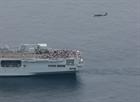Sea Fury and HMS Ocean
With the Queens Diamond Jubilee taking centre stage across the country another memory of over sixty decades ago has seen HMS Ocean and a Hawker Sea Fury recreate an association from the Korean War.
With the roar of a Bristol Centaurus radial engine powering the Royal Naval Historic Flight’s Sea Fury heard once again over the flight deck of HMS Ocean, the Royal Navy’s largest Warship, spectators were thrilled and entertained by the 65 year old aircraft’s display at HMS Ocean’s family’s day. Lynx helicopters from the RN Black Cats team gave an exciting warm up show of modern maritime air power, staged off the South coast of Devon, but it was the Iconic aircraft from the 1950’s that stole the show. The Maritime fighters operated from the “Mighty O” during the Korean War. It was then the Sea Fury squadrons embarked, added some legendary anecdotes to Fleet Air Arm History.
The current HMS Ocean is the sixth ship of that name to serve in the Royal Navy and it’s the fifth, also a carrier of the Colossus Class commissioned at the end of the second World War in 1945, operating with Fairey Firefly and Hawker Sea Furies aircraft served in Korean waters from 1950 to 1953, maintaining a tight blockade on North Korea. In addition carrier based naval aviation played a leading role in air support to the Commonwealth and American forces on the ground.
The Hawker Sea Fury was a single-seat, single-engine, carrier-based fighter-bomber. In total 615 were built serving across the British Commonwealth Navies of Australia, Canada and the Royal Navy. It had a powerful 2,480-hp engine, a maximum speed of 460 mph, was armed with four 20mm cannon, and could carry up to 2,000 lbs. of external ordnance.
When the War broke out in 1950, the Sea Fury was the Fleet Air Arm's leading single-seat fighter. The aircraft were mainly used in the ground attack role armed with bombs and rockets, but they were also engaged in air-to-air combat with the much faster MiG-15. On 9 August 1952 a Flight of Sea Furies from 802 Squadron flown by Lieutenants Carmichael and Davis, and Sub-Lieutenants Haines and Ellis, were on an armed reconnaissance flight in an area just North of Chinimpo on the Korean peninsula when they were attacked by eight enemy MiG-15s.
Despite the enemy's superiority in numbers and a 200 mph speed advantage, the Sea Fury pilots shot down one MiG and badly damaged two others without incurring any damage to their own aircraft. As Flight leader, Lieutenant Carmichael was officially accredited with the 'kill' and was subsequently awarded the Distinguished Service Cross for his heroism, but all of the other pilots officially claimed their quarter share.
The Sea Fury was to go on to serve in the FAA for a further year before being replaced by the Royal Navy’s first jet the Sea Hawk.
The Sea Fury flying today was piloted by Lieutenant Commander Chris Gotke who said,” Being able to fly the Sea Fury is a dream come true, she has excellent handling characteristic making it a really good weapons delivery platform borne out by her operations over Korea. It’s a privilege to be able to fly the aircraft, particularly when linked to occasions such as this”
“The RNHF have been displaying naval aircraft around the United Kingdom for 40 years, the Flight having been created in 1972. In this 40th year the RNHF now operate Swordfish and the only airworthy Sea Hawk in the world, in addition to the Sea Fury. Arguably the greatest piston engine Naval fighter of all time.” Said Katy Campbell, the Display Manager for the Royal Navy Historic Flight.





